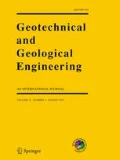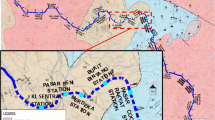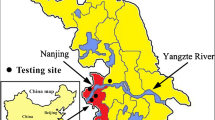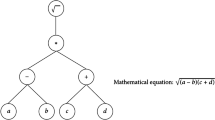Abstract
Pressuremeter modulus (\(E_{M}\)) and limit pressure (\(P_{L}\)) are used for the calculation of the settlement and bearing capacity of foundation respectively. As the determination of these parameters from pressuremeter test (PMT) is relatively time-consuming and expensive, various empirical correlations have been proposed to correlate the \(E_{M}\) and \(P_{L}\) to other soil parameters. For the existing equations are incapable of estimating these PMT parameters well, in present research group method of data handling type neural network is used to estimate the \(E_{M}\) and \(P_{L}\) of clayey soils. The \(E_{M}\) and \(P_{L}\) were modeled as a function of three variables including the moisture content (\(\omega\)), plasticity index and corrected SPT blow counts (\(N_{60}\)). A database containing 51 data sets have been used for training and testing of the models. The performances of proposed models are compared with those of existing empirical equations. The results demonstrate that appreciable improvement with respect to the other correlations has been achieved. At the end, sensitivity analysis of the obtained models has been performed to study the influence of input parameters on model outputs and shows that the \(N_{60}\) is the most influential parameter on the PMT parameters.













Similar content being viewed by others
Abbreviations
- \(C_{mi}\) :
-
Measured output
- \(C_{pi}\) :
-
Predicted output
- \(E_{r}\) :
-
Scaled relative error
- \(E_{M}\) :
-
Pressuremeter modulus
- M :
-
Total numbers of data sets
- MAD :
-
Mean absolute deviation
- MAPE :
-
Mean absolute percent error
- \(m_{i}\) :
-
Input parameter
- \(m_{j}\) :
-
output parameter
- N :
-
SPT blow counts
- \(N_{60}\) :
-
Corrected SPT blow counts
- PI :
-
Plastic index (%)
- \(P_{a}\) :
-
Atmospheric pressure
- \(P_{L}\) :
-
Limit pressure
- RMSE :
-
Root mean square error
- \(R^{2}\) :
-
Absolute fraction of variance
- SCF :
-
Scaled cumulative frequency
- X :
-
Input variable
- y :
-
Actual output
- \(\omega\) :
-
Moisture content (%)
References
Agan C (2014) Determination of the deformation modulus of dispersible–intercalated–jointed cherts using the Menard pressuremeter test. Int J Rock Mech Min Sci 65:20–28. doi:10.1016/j.ijrmms.2013.11.004
Ardalan H, Eslami A, Nariman-Zadeh N (2009) Piles shaft capacity from CPT and CPTu data by polynomial neural networks and genetic algorithms. Comput Geotech 36(4):616–625. doi:10.1016/j.compgeo.2008.09.003
Ardakani A, Kordnaeij A (2017) Soil compaction parameters prediction using GMDH-type neural network and genetic algorithm. Eur J Environ Civ Eng 1–14. doi:10.1080/19648189.2017.1304269
Baguelin F, Jezequel JF, Shields DH (1978) The pressuremeter and foundation engineering. Trans Tech Publications, Clausthal
Bozbey L, Togrol E (2010) Correlation of standard penetration test and pressuremeter data: a case study from Istanbul, Turkey. Bull Eng Geol Environ 69(4):505–515. doi:10.1007/s10064-009-0248-4
Briaud JL (1992) The pressuremeter. Balkema, Rotterdam
Cheshomi A, Ghodrati M (2014) Estimating Menard pressuremeter modulus and limit pressure from SPT in silty sand and silty clay soils. A case study in Mashhad, Iran. Geomech Geoeng Int J 10(3):194–202. doi:10.1080/17486025.2014.933894
Das SK (2013) 10-Artificial neural networks in geotechnical engineering: modeling and application issues. Metaheuristics Water Geotech Transp Eng. doi:10.1016/B978-0-12-398296-4.00010-6
Das SK, Basudhar PK (2007) Prediction of hydraulic conductivity of clay liners using artificial neural network. Lowl Technol Int Off J Int Assoc Lowl Technol (IALT)/Inst Lowl Technol Saga Univ 9(1):50–58
Das SK, Biswal RK, Sivakugan N, Das B (2011a) Classification of slopes and prediction of factor of safety using differential evolution neural networks. Environ Earth Sci 64(1):201–210. doi:10.1007/s12665-010-0839-1
Das SK, Pijush S, Akshaya KS (2011b) Prediction of field hydraulic conductivity of clay liners using an artificial neural network and support vector machine. Int J Geomech 12(5):606–611. doi:10.1061/(ASCE)GM.1943-5622.0000129
Das SK, Samui P, Sabat AK (2011c) Application of artificial intelligence to maximum dry density and unconfined compressive strength of cement stabilized soil. Geotech Geol Eng 29(3):329–342. doi:10.1007/s10706-010-9379-4
Emami M, Yasrobi SS (2014) Modeling and interpretation of pressuremeter test results with artificial neural networks. Geotech Geol Eng 32(2):375–389. doi:10.1007/s10706-013-9720-9
Eslami A, Mola-Abasi J, Tabatabaeishorijeh P (2014) A polynomial model for liquefaction potential prediction from CPT data. Sceintia Iranica 21(1):44–52
Farlow SJ (1984) Self-organizing method in modelling: GMDH type algorithm. Marcel Dekker Inc., New York
Garg V (2014) Inductive group method of data handling neural network approach to model basin sediment yield. J Hydrol Eng 20(6):C6014002
Ivakhnenko AG (1971) Polynomial theory of complex systems. IEEE Trans Syst Man Cybern 1:364–378. doi:10.1109/TSMC.1971.4308320
Kainthola A, Singh PK, Verma D, Singh R, Sarkar K, Singh TN (2015) Prediction of strength parameters of himalayan rocks: a statistical and ANFIS approach. Geotech Geol Eng 33(5):1255–1278. doi:10.1007/s10706-015-9899-z
Kalantary F, Kordnaeij A (2012) Prediction of compression index using artificial neural network. Sci Res Essays 7(31):2835–2848. doi:10.5897/SRE12.297
Kalantary F, Ardalan H, Nariman-Zadeh N (2009) An investigation on the Su–NSPT correlation using GMDH type neural networks and genetic algorithms. Eng Geol 104(1):144–155. doi:10.1016/j.enggeo.2008.09.006
Kayabasi A (2012) Prediction of pressuremeter modulus and limit pressure of clayey soils by simple and non-linear multiple regression techniques: a case study from Mersin, Turkey. Environ Earth Sci 66(8):2171–2183. doi:10.1007/s12665-011-1439-4
Kordnaeij A, Kalantary F, Kordtabar B, Mola-Abasi H (2015) Prediction of recompression index using GMDH-type neural network based on geotechnical soil properties. Soils Found 55(6):1335–1345. doi:10.1016/j.sandf.2015.10.001
Mohammadzadeh SD, Bolouri Bazaz J, Alavi AM (2014) An evolutionary computational approach for formulation of compression index of fine-grained soils. Eng Appl Artif Intell 33:58–68. doi:10.1016/j.engappai.2014.03.012
MolaAbasi H, Shooshpasha I (2016) Prediction of zeolite–cement–sand unconfined compressive strength using polynomial neural network. Eur Phys J Plus 131(4):1–12. doi:10.1140/epjp/i2016-16108-5
Mola-Abasi H, Eslami A, Tabatabaeishorijeh P (2013) Shear wave velocity by polynomial neural networks and genetic algorithms based on geotechnical soil properties. Arab J Sci Eng 38(4):829–838. doi:10.1007/s13369-012-0525-6
Mola-Abasi H, Dikmen U, Shooshpasha I (2015) Prediction of shear-wave velocity from CPT data at Eskisehir (Turkey), using a polynomial model. Near Surf Geophys 13(2):155–167. doi:10.3997/1873-0604.2015010
Momeni E, Nazir R, Jahed Armaghani D, Maizir H (2014) Prediction of pile bearing capacity using a hybrid genetic algorithm-based ANN. Measurement 57:122–131. doi:10.1016/j.measurement.2014.08.007
Muduli PK, Das SK, Bhattacharya S (2014) CPT-based probabilistic evaluation of seismic soil liquefaction potential using multi-gene genetic programming. Georisk Assess Manag Risk Eng Syst Geohazards 8(1):14–28. doi:10.1080/17499518.2013.845720
Najafzadeh M, Barani GA, Kermani MRH (2013) GMDH based back propagation algorithm to predict abutment scour in cohesive soils. Ocean Eng 59:100–106. doi:10.1016/j.oceaneng.2012.12.006
Oommen T, Baise LG (2010) Model development and validation for intelligent data collection for lateral spread displacements. J Comput Civil Eng 24(6):467–477. doi:10.1061/(ASCE)CP.1943-5487.0000050
Pal M, Deswal S (2014) Extreme learning machine based modeling of resilient modulus of subgrade soils. Geotech Geol Eng 32(2):287–296. doi:10.1061/_ASCE_CP.1943-5487.0000050
Shahri AA (2016a) An optimized artificial neural network structure to predict clay sensitivity in a high landslide prone area using piezocone penetration test (CPTu) data: a case study in southwest of Sweden. Geotech Geol Eng 34(2):745–758. doi:10.1007/s10706-016-9976-y
Shahri AA (2016b) Assessment and prediction of liquefaction potential using different artificial neural network models: a case study. Geotech Geol Eng. doi:10.1007/s10706-016-0004-z
Varghese VK, Babu SS, Bijukumar R, Cyrus S, Abraham BM (2013) Artificial neural networks: a solution to the ambiguity in prediction of engineering properties of fine-grained soils. Geotech Geol Eng 31(4):1187–1205. doi:10.1007/s10706-013-9643-5
Yagiz S, Akyol E, Sen G (2008) Relationship between the standard penetration test and the pressuremeter test on sandy silty clays: a case study from Denizli. Bull Eng Geol Environ 67(3):405–410. doi:10.1007/s10064-008-0153-2
Ziaie Moayed R, Kordnaeij A, Mola-Abasi H (2016) Compressibility indices of saturated clays by group method of data handling and genetic algorithms. Neural Comput Appl. doi:10.1007/s00521-016-2390-9
Žlender B, Jelušič P, Boumezerane D (2012) Planning geotechnical investigation using ANFIS. Geotech Geol Eng 30(4):975–989. doi:10.1007/s10706-012-9520-7
Author information
Authors and Affiliations
Corresponding author
Appendix
Rights and permissions
About this article
Cite this article
Ziaie Moayed, R., Kordnaeij, A. & Mola-Abasi, H. Pressuremeter Modulus and Limit Pressure of Clayey Soils Using GMDH-Type Neural Network and Genetic Algorithms. Geotech Geol Eng 36, 165–178 (2018). https://doi.org/10.1007/s10706-017-0314-9
Received:
Accepted:
Published:
Issue Date:
DOI: https://doi.org/10.1007/s10706-017-0314-9





